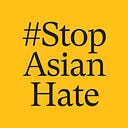What the Media Gets Wrong About Anti-Asian Hate
We need to arm ourselves with knowledge, not guns
Over the past year, I have witnessed with alarm the increased attention to violence against Asian Americans. As someone who has studied and taught about anti-Asian discrimination for nearly two decades, my concerns were intensified by news coverage and viral videos featuring elderly Asian Americans being brutally attacked. I saw a narrative unfolding — that Asian Americans were facing a unique level of hostility relative to other groups and that it was the most vulnerable members of our community who were bearing the brunt of physical assaults.
The disturbing level of anti-Asian violence has been deeply felt by our communities and is entrenched in U.S. history. The news media, especially Asian American journalists, should be commended for insisting we pay attention to the story of anti-Asian bias so that more people acknowledge the racism Asian Americans have faced.
But we must also step back and examine the assumptions we are making about anti-Asian hate. Too often, crime is understood from a visceral perspective. Media coverage has heightened fears among Asian Americans, such that many are afraid to venture out in public, are buying guns for self-protection, and are taking self-defense classes.
The media also tends to distort crime in the United States — with crime coverage particularly perpetuating racist stereotypes of Black people. In many cases, the most viral videos of anti-Asian hate have featured attacks by Black men. In some cases, the reporting on these attacks has failed to distinguish between violence motivated by hate versus violence motivated by economic or other factors.
As part of several organizations working to combat anti-Asian discrimination, I recently summarized four types of data from nine different sources of anti-Asian hate incidents, focusing on statistics and studies published over the past year and a half.
What I found in my review of the data, which can be accessed in this full report, helps put anti-Asian violence in perspective. These statistics tell a very different story from the media coverage. They show that while there has been an increase in anti-Asian hate since the start of the pandemic, it is mostly not physical attacks, not more widespread than that faced by other racial groups, not targeted at the elderly, and does not mostly involve Black offenders.
It is understandable that Asian Americans are reacting with fear to the coverage of anti-Asian hate incidents; one-third of all Asian Americans are worried about being the victim of a hate crime. But we need to arm ourselves with knowledge, not guns. We can’t let headlines damage our mental health and well-being or prevent us from going outside and living our lives, especially when research shows that Americans tend to overestimate their risk of being victims of crimes. And, as Jeff Yang has written, we need to end our use of racist tropes against Black Americans.
We can’t let headlines damage our mental health and well-being or prevent us from going outside and living our lives.
Here are five main takeaways from my review. (Note that the term “hate crime” refers to incidents classified by law enforcement as a “hate crime” or referred to in survey questions explicitly as a “hate crime.” The terms “hate incident” and “anti-Asian harassment” are used in other cases, in alignment with the terminology used in the data source referenced.)
1. Most incidents are not physical attacks
StopAAPIHate, a community-based reporting site, suggests that the majority of reported incidents (83%) consist of “verbal harassment” (65%) and “shunning” (18%) with just over 12% consisting of physical assaults. Similar patterns were reported by the Virulent Hate Project at the University of Michigan, which found that 80% of incidents fell into the verbal assault or avoidance category, and 17% consisted of physical harassment, including spitting, coughing, and sneezing.
Verbal attacks are a form of violence, and any violent incident is one too many. But because physical assault constitutes a relatively small proportion of all hate incidents, we must not assume that we are constantly under threat of physical attack.
2. Reported anti-Asian hate crimes and incidents increased but from a relatively low baseline
Fear of anti-Asian hate crime is very real, with eight in 10 Asian Americans saying anti-Asian violence is increasing. Indeed, most surveys with large Asian American samples show evidence of increased reporting of hate crimes among Asian Americans since the start of the pandemic.
Official law enforcement statistics also show an increase. But, even in New York City—which is characterized by the most dramatic year-over-year increases (three reported anti-Asian crimes in 2019 to 28 reported anti-Asian crimes in 2020, an increase of 833%)—anti-Asian hate crimes accounted for only 11% of all reported hate crimes in 2020. That’s less than the 14% that Asian Americans make up of the population.
Anti-Asian hate crimes have historically been reported at numbers far below other racial groups in part because of the relatively small Asian American population size. But in fact, the number of anti-Asian hate crimes reported to law enforcement was higher in 1996 than in 2019. Overall, reported anti-Asian hate crimes represented 6.7% of all reported hate crimes in 16 of the largest U.S. jurisdictions in 2020.
3. Racist incidents against other non-white groups demonstrate the endemic nature of hate faced by Asian Americans and other groups
Official law enforcement data show that in 2019, Black people continued to be the most targeted racial group. In that year, 58% of reported hate crimes were motivated by anti-Black bias, 14% by anti-Hispanic bias, and 4% by anti-Asian bias.
This aligns with historical data documented in a 2021 publication by Yan Zhang and colleagues. Focusing on violent crimes in particular, they found that there were 329 violent anti-Asian hate crimes, 5,463 violent anti-Black hate crimes, and 1,355 violent anti-Hispanic hate crimes between 1992 and 2014.
During the pandemic, Asian Americans were also not the only group being targeted. A 2021 Civis Analytics study shows that 25% of American Indian/Alaskan Natives, 17% of Asian Americans, 16% of Black African/Americans, and 12% of Hispanics/Latinos indicated they had experienced “Covid-19-related discrimination since March of 2020.” Survey data from AAPI Data/SurveyMonkey also show that 27% of Asian Americans reported ever experiencing a hate crime or hate incident. Meanwhile, 34% of Black, 27% of Latino, 25% of Native American, and 24% of Pacific Islander respondents reported ever experiencing a hate crime or hate incident.
4. Asian American elders are not disproportionately targeted
Over the course of the pandemic, about 7% of people reporting to StopAAPIHate were over age 60. The University of Michigan analysis shows that about 3% of Asian American victims identified in news coverage were seniors. Survey data from AAPI Data/Survey Monkey show that in the first months of 2021, 8% of Asian Americans 65 and older say they experienced a hate crime, compared to 14% of those 18–34 years old.
5. Offenders are mostly white
As with other crime coverage, viral media coverage of anti-Asian crimes overrepresent Black offenders, but multiple data sources show an age-old historical pattern of white people being responsible for the majority of anti-Asian violence.
Official law enforcement statistics compiled by Zhang and colleagues in their 2021 study (data are pre-pandemic) show that 75% of offenders in violent anti-Asian hate crimes are white. About 25% of the offenders in anti-Asian crimes were non-white versus 1% of the offenders in anti-Black hate crimes and 19% of the offenders in anti-Hispanic hate crimes. Almost all of the offenders in violent anti-Black hate crimes were white. Contemporaneous data collected during the pandemic shows similar patterns.
There is no doubt that AAPI communities have been hit hard by the pandemic and pandemic-related racism. But these data demonstrate that we must view prevailing media narratives with a more critical eye. Asian Americans are certainly experiencing an increase in anti-Asian incidents and discrimination, but we are not alone. We are experiencing hate that has long been part of the day-to-day lives of other marginalized communities, including people of color, LGBTQ+ people, and religious minorities, who continue to face hate crimes and incidents as well.
In this time of heightened attention to anti-Asian violence, we can empower our communities with knowledge and thoughtful interpretation of data. And these data show that a media narrative that amplifies anti-Asian physical attacks against the elderly by Black perpetrators is misleading. Further, a media narrative that divorces experiences with discrimination among Asian Americans from that of other marginalized groups fails to show how we are all connected. Instead, we must unite, mobilize, and fight hate together.

